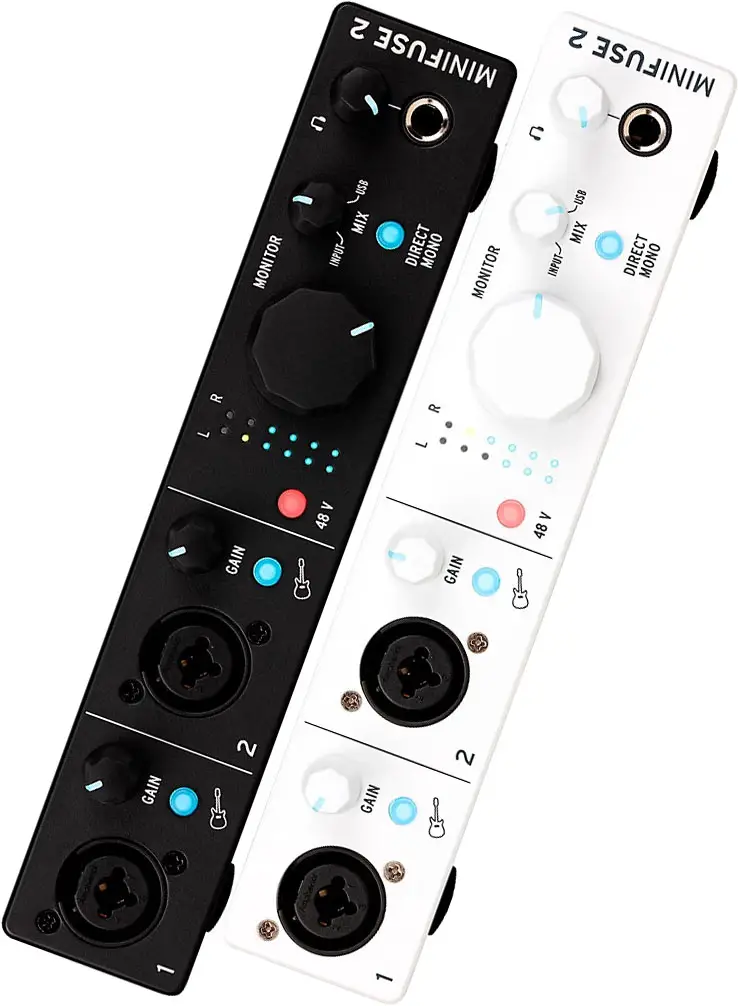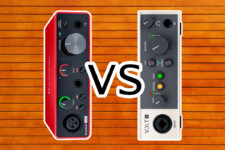Focusrite Scarlett Solo 3rd Gen vs Arturia MiniFuse 2: Which One Should You Choose?
If you are looking for a compact and portable USB audio interface for your home recording studio, you might have come across two popular options: the Focusrite Scarlett Solo 3rd Gen and the Arturia MiniFuse 2. Both of these devices are designed to provide high-quality sound and performance for singers, songwriters, podcasters, and other audio enthusiasts.
But how do they compare and what are the main differences between them? In this article, we will help you understand the pros and cons of each interface and help you decide which one is best for your needs.

A Quick Look
If you are looking for a simple and affordable interface that can add some warmth and brightness to your vocals and acoustic instruments, you might want to choose the Focusrite Scarlett Solo 3rd Gen. The Air mode can help you achieve a more airy and open sound that cuts through the mix better. The gain halo indicators can also help you set the optimal gain level for your recordings and avoid distortion or noise. The Focusrite Scarlett Solo 3rd Gen also comes with more plugins and a Splice Sounds subscription that can help you enhance your productions.
If you are looking for a more versatile and flexible interface that can connect other devices to your computer, you might want to choose the Arturia MiniFuse 2. The USB hub can help you save space and avoid clutter on your desk. The multi-segment LED meters can also help you monitor the input and output levels of your recordings and avoid clipping or low volume. The Arturia MiniFuse 2 also comes with more plugins from Arturia that can help you create unique and inspiring sounds.

Focusrite Scarlett Solo 3rd Gen
- Mobile-ready, bus-powered, 2-in/2-out USB-C.
- Record at up to 24-bit/192kHz resolution.
- Two combo mic/line/instrument inputs with mic preamps.
- Two balanced 1/4″ TRS main outputs.
- Switchable Air mode that gives recordings a brighter and more open sound.
- Unique and intuitive halo level indicators that show you the input level and signal clipping at a glance.
- A direct monitor circuit that lets you monitor your input with low latency in one click.

Arturia MiniFuse 2
- Two combo XLR/TRS inputs that can handle mic, line, or instrument signals.
- 48V phantom power for condenser microphones.
- Two balanced TRS outputs for connecting to monitors or speakers.
- MIDI in/out ports for connecting MIDI devices.
- One USB-A port that acts as a hub for connecting USB devices.
- One USB-C port for connecting to a computer and bus- powering the interface.
- Integrated LED meters on the front panel that show the input and output levels.
- Direct monitor mix knob that lets you adjust the balance between the input and playback signals.
Common Features
- One mic input and one line/instrument input: Both interfaces have one XLR mic input and one 1/4″ line/instrument input on the front panel. This means you can record vocals and guitar or keyboard at the same time, or connect a microphone to capture any sound source.
- 24-bit/192 kHz resolution: Both interfaces support high-resolution audio recording and playback, which means you can capture every detail of your sound source and enjoy clear and crisp sound quality.
- Phantom power: Both interfaces provide +48V phantom power to the mic input, which allows you to use condenser microphones that require external power. This is useful if you want to record vocals or acoustic instruments with a more detailed and accurate sound.
- Direct monitoring: Both interfaces have a direct monitoring feature that lets you hear your input signal without any latency or delay caused by your computer. This is helpful if you want to record with headphones and avoid hearing any echo or lag in your performance.
- MIDI I/O: Both interfaces have a MIDI input and output on the back panel, which allows you to connect MIDI keyboards, controllers, or other devices to your computer. This is useful if you want to use virtual instruments, trigger samples, or control parameters in your software.
- Bundled software: Both interfaces come with a variety of software that can help you start recording right away. See the end of this article for a full list.
Focusrite Scarlett Solo 3rd Gen: Individual Features
- Air mode: The Focusrite Scarlett Solo 3rd Gen has a feature called Air mode that can be activated by pressing a button on the front panel. This feature emulates the sound of the original Focusrite ISA preamp, which adds brightness and clarity to vocals and acoustic instruments. This can help you achieve a more airy and open sound that cuts through the mix better.
- Gain halo indicators: Has LED rings around the gain knobs that indicate the input level of your signal. The rings light up green when the signal is at a good level, red when the signal is clipping, and off when there is no signal. This can help you set the optimal gain level for your recordings and avoid distortion or noise.
Arturia MiniFuse 2: Individual Features
- USB hub: The Arturia MiniFuse 2 has a feature called USB hub that allows you to connect other devices to your computer via the interface. The interface has two USB-A ports on the back panel, which can provide power and data transfer to other USB devices, such as MIDI controllers, hard drives, or dongles. This can help you save space and avoid clutter on your desk.
- Multi-segment LED meters: Has four multi-segment LED meters on the front panel that indicate the input and output levels of your signal. The meters have eight segments each, with green, yellow, and red colors. This can help you monitor the input and output levels of your recordings and avoid clipping or low volume.
Price Comparison
The Focusrite Scarlett Solo 3rd Gen and the Arturia MiniFuse 2 are both affordable audio interfaces that offer great value for money. However, there is a slight difference in their price, depending on where you buy them from. The Focusrite Scarlett Solo 3rd Gen sells for around $130, while the Arturia MiniFuse 2 is priced at $150.
Sound Quality
The sound quality of an audio interface depends on several factors, such as the quality of the preamps, converters, drivers, and software.
The Focusrite Scarlett Solo 3rd Gen has a slightly warmer and smoother sound that can add some color and richness to your recordings. The Air mode can also enhance the high frequencies and add some sparkle and presence to your vocals and acoustic instruments. The Arturia MiniFuse 2 has a slightly cleaner and more neutral sound that can capture your sound source more accurately and faithfully.
Both interfaces have low noise and distortion levels, high dynamic range, and low latency performance. They also support high-resolution audio recording and playback up to 24-bit/192 kHz, which means you can capture every detail of your sound source and enjoy clear and crisp sound quality.
Compatibility
Both the Focusrite Scarlett Solo 3rd Gen and the Arturia MiniFuse 2 are compatible with Windows and Mac computers, as well as iOS devices (with an adapter). They use USB-C protocol to connect to your computer or device, which means they are plug-and-play and do not require any external power supply. They also come with drivers and software that can help you set up and configure your interface easily.
Both interfaces are also compatible with most popular DAWs (digital audio workstations), such as Ableton Live, Pro Tools, Logic Pro X, Cubase, FL Studio, Reaper, GarageBand, etc.
Focusrite Scarlett Solo 3rd Gen Pros
- Gain halo indicators help set optimal gain level.
- High-quality preamp that delivers a clear and natural sound.
- Air mode that emulates the sound of the Focusrite ISA preamp, adding brightness, presence, and clarity to recordings.
- Low-latency mode that lets you monitor your performance in real time without any delay.
Focusrite Scarlett Solo 3rd Gen Cons
- Only one mic preamp and one line/instrument input.
- No MIDI in/out ports, which limits your connectivity options with MIDI devices.
- No USB hub port, which means you cannot connect other USB devices to it without using a separate hub.
- No direct monitor mix knob, which means you cannot adjust the balance between the input and playback signals.
Arturia MiniFuse 2 Pros
- MIDI in/out ports, which allows you to connect MIDI devices such as keyboards, drum machines, and controllers.
- USB hub port, which lets you connect another USB device to it, such as an iLok or a flash drive.
- Direct monitor mix knob, which lets you adjust the balance between the input and playback signals.
- Multi-segment LED meters help monitor input and output levels.
Arturia MiniFuse 2 Cons
- Lower-quality preamp than the Focusrite Scarlett Solo 3rd Gen, which may result in a less clear and natural sound.
- No Air mode or any other special feature that enhances the sound quality of your recordings.
- No low-latency mode, which means you may experience some delay when monitoring your performance.
Focusrite Scarlett Solo 3rd Gen vs Arturia MiniFuse 2: The Final Verdict
The Focusrite Scarlett Solo 3rd Gen and the Arturia MiniFuse 2 are both excellent audio interfaces that can meet your home recording needs. They have similar features and performance, but also some distinctive features that make them unique and different from each other. Ultimately, the choice between them depends on your personal preference, budget, and recording situation.
If you want a simple and affordable interface that can add some warmth and brightness to your vocals and acoustic instruments, go for the Focusrite Scarlett Solo 3rd Gen. If you want a more versatile and flexible interface that can connect other devices to your computer, go for the Arturia MiniFuse 2.
Either way, you won’t regret choosing either of these interfaces, as they are both reliable, easy-to-use, and high-quality devices that can help you record amazing sound at home. We hope this article has helped you understand the pros and cons of each interface and make an informed decision. Happy recording!
Focusrite Scarlett Solo 3rd Gen: Bundled Software
- Ableton Live Lite (a lite version of a popular DAW).
- Pro Tools First Focusrite Creative Pack (a lite version of another popular DAW with some plugins).
- Three months of Splice Sounds subscription (a platform that offers royalty-free samples, loops, and presets).
- Focusrite Red Plug-in Suite (a collection of EQ and compressor plugins).
- Softube Time and Tone Bundle (a collection of reverb, delay, distortion, and modulation plugins).
- XLN Audio Addictive Keys (a virtual piano plugin).
- Focusrite Plug-in Collective (a program that offers free plugins every few months).
Arturia MiniFuse 2: Bundled Software
- Ableton Live Lite (a lite version of a popular DAW).
- Analog Lab Lite (a collection of over 600 synth sounds from Arturia’s V Collection).
- Bitwig Studio 8-Track (a lite version of a DAW with eight tracks).
- UVI Model D (a virtual piano plugin based on the Steinway Model D grand piano).
- Spitfire Audio LABS – Expressive Strings (a virtual string ensemble plugin).
- FX Collection Lite (a collection of three classic effects plugins from Arturia: Rev PLATE-140 reverb, Delay TAPE-201 delay, Pre TridA preamp).





